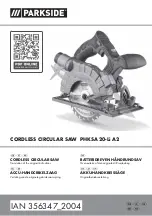
6
(2) When cutting metallic materials, use proper machine
oil (turbine oil, etc.). When not using liquid machine
oil, apply grease over the workpiece.
CAUTION
The service life of the saw blade will be drastically
shortened if you don’t use machine oil.
(3) Use the dial to adjust the speed of the saw blade to
suit your working conditions and materials.
2. Cutting lumber
(1) When cutting lumber, make sure that the workpiece
is fastened firmly before beginning. (
Fig. 20
)
Fig. 20
(2) You can cut efficiently if the speed of the saw blade
is set to dial scale “5”.
CAUTION
䡬
Never apply any unreasonable force to the saw blade
when cutting. Also remember to press the base
against the lumber firmly.
3. Sawing curved lines
We recommend that you use the BI-METAL blade
mentioned in
Table 2
(Page
9
) for the saw blade since
it is tough and hardly breaks.
CAUTION
Delay the feed speed when cutting the material into
small circular arcs. An unreasonably fast feed may
break the blade.
4. Plunge cutting
With this tool, you can perform plunge cutting on
plywood panels and thin board materials. You can
carry out pocket cutting quite easily with the saw blade
installed in reverse as illustrated in
Fig. 22
,
Fig. 24
,
and
Fig. 26
. Use the saw blade that is as short and
thick as possible. We recommend for this purpose that
you use BI-METAL Blade No. 132 mentioned in Page
9
,
Table 2
. Be sure to use caution during the cutting
operation and observe the following procedures.
(1) Press the lower part (or the upper part) of the base
against the material. Pull the switch trigger while
keeping the tip of the saw blade apart from the
material. (
Fig. 21
,
Fig. 22
)
Fig. 21
Fig. 22
(2) Raise the handle slowly and cut in with the saw blade
little by little. (
Fig. 23
,
Fig. 24
)
Fig. 23
Fig. 24
(3) Hold the body firmly until the saw blade completely
cuts into the material. (
Fig. 25
,
Fig. 26
)
Fig. 25
Fig. 26
Summary of Contents for CR13VC
Page 11: ...10 ...
Page 12: ...305 Code No C99117211 N Printed in Japan Hitachi Koki Co Ltd ...






























